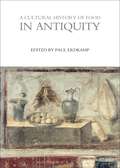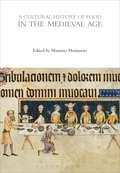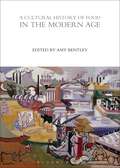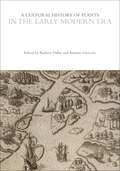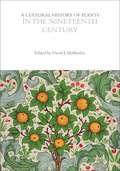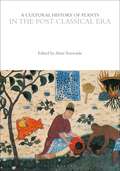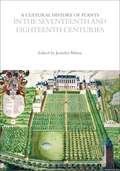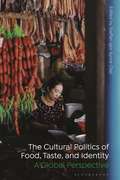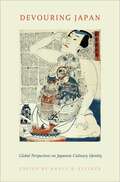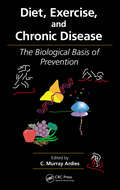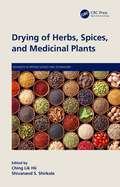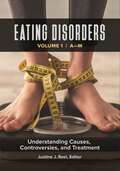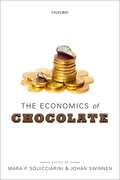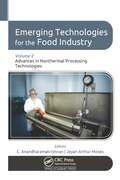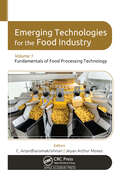- Table View
- List View
Courgette (UEB Uncontracted)
This is an image of a green courgette, sometimes known as zucchini, in the middle of the page. There is a locator dot shown, which will be at the top left of the page when the image is the correct way up. The courgette's stalk is in the top left of the page, the main body of the fruit extends down and right to the little bump on the end of the fruit where the flower was once attached. There are lines on the image that represent slight ridges that run the length of the courgette.
A Cultural History of Food in Antiquity (The Cultural Histories Series)
From Archaic Greece until the Late Roman Empire (c. 800 BCE to c. 500 CE), food was more than a physical necessity; it was a critical factor in politics, economics and culture. On the one hand, the Mediterranean landscape and climate encouraged particular crops – notably cereals, vines and olives – but, with the risks of crop failure ever-present, control of food resources was vital to economic and political power. On the other hand, diet and dining reflected complex social hierarchies and relationships. What was eaten, with whom and when was a fundamental part of the expression of one's role and place in society. In addition, symbolism and ritual suffused foodstuffs, their preparation and consumption.A Cultural History of Food in Antiquity presents an overview of the period with essays on food production, food systems, food security, safety and crises, food and politics, eating out, professional cooking, kitchens and service work, family and domesticity, body and soul, representations of food, and developments in food production and consumption globally.
A Cultural History of Food in the Age of Empire (The Cultural Histories Series)
The nineteenth-century West saw extraordinary economic growth and cultural change. This volume explores and explains the birth of the modern world through the food it produced and consumed. Food security vastly improved though malnutrition and famines persisted. Scientific research radically altered the ways in which food and its relation to the body were conceived: efficiency became the watchword, norms the measure, and standardized goods the rule. At the same time, the art of food became a luxury pursuit as interest in gastronomy soared.A Cultural History of Food in the Age of Empire presents an overview of the period with essays on food production, food systems, food security, safety and crises, food and politics, eating out, professional cooking, kitchens and service work, family and domesticity, body and soul, representations of food, and developments in food production and consumption globally.
A Cultural History of Food in the Early Modern Age (The Cultural Histories Series)
The seventeenth and eighteenth centuries form a very distinctive period in European food history. This was a time when enduring feudal constraints in some areas contrasted with widening geographical horizons and the emergence of a consumer society.While cereal based diets and small scale trade continued to be the mainstay of the general population, elite tastes shifted from Renaissance opulence toward the greater simplicity and elegance of dining à la française. At the same time, growing spatial mobility and urbanization boosted the demand for professional cooking and commercial catering. An unprecedented wealth of artistic, literary and medical discourses on food and drink allows fascinating insights into contemporary responses to these transformations.A Cultural History of Food in the Early Modern Age presents an overview of the period with essays on food production, food systems, food security, safety and crises, food and politics, eating out, professional cooking, kitchens and service work, family and domesticity, body and soul, representations of food, and developments in food production and consumption globally.
A Cultural History of Food in the Medieval Age (The Cultural Histories Series)
Europe was formed in the Middle Ages. The merging of the traditions of Roman-Mediterranean societies with the customs of Northern Europe created new political, economic, social and religious structures and practices. Between 500 and 1300 CE, food in all its manifestations, from agriculture to symbol, became ever more complex and integral to Europe's culture and economy. The period saw the growth of culinary literature, the introduction of new spices and cuisines as a result of trade and war, the impact of the Black Death on food resources, the widening gap between what was eaten by the rich and what by the poor, as well as the influence of religion on food rituals.A Cultural History of Food in the Medieval Age presents an overview of the period with essays on food production, food systems, food security, safety and crises, food and politics, eating out, professional cooking, kitchens and service work, family and domesticity, body and soul, representations of food, and developments in food production and consumption globally.
A Cultural History of Food in the Modern Age (The Cultural Histories Series)
In the modern age (1920–2000), vast technological innovation spurred greater concentration, standardization, and globalization of the food supply. As advances in agricultural production in the post-World War II era propelled population growth, a significant portion of the population gained access to cheap, industrially produced food while significant numbers remained mired in hunger and malnutrition. Further, as globalization allowed unprecedented access to foods from all parts of the globe, it also hastened environmental degradation, contributed to poor health, and remained a keyelement in global politics, economics and culture.A Cultural History of Food in the Modern Age presents an overview of the period with essays on food production, food systems, food security, safety and crises, food and politics, eating out, professional cooking, kitchens and service work, family and domesticity, body and soul, representations of food, and developments in food production and consumption globally.
A Cultural History of Food in the Renaissance (The Cultural Histories Series)
Food and attitudes toward it were transformed in Renaissance Europe. The period between 1300 and 1600 saw the discovery of the New World and the cultivation of new foodstuffs, as well as the efflorescence of culinary literature in European courts and eventually in the popular press, and most importantly the transformation of the economy on a global scale. Food became the object of rigorous investigation among physicians, theologians, agronomists and even poets and artists. Concern with eating was, in fact, central to the cultural dynamism we now recognize as the Renaissance.A Cultural History of Food in the Renaissance presents an overview of the period with essays on food production, food systems, food security, safety and crises, food and politics, eating out, professional cooking, kitchens and service work, family and domesticity, body and soul, representations of food, and developments in food production and consumption globally.
A Cultural History of Plants in Antiquity (The Cultural Histories Series)
A Cultural History of Plants in Antiquity covers the period from 10,000 BCE to 500 CE. This period witnessed the transition from hunter-gatherer subsistence to the practice of agriculture in Mesopotamia and elsewhere, and culminated in the fall of the Roman Empire, the end of the Han Dynasty in China, the rise of Byzantium, and the first flowering of Mayan civilization. Human uses for and understanding of plants drove cultural evolution and were inextricably bound to all aspects of cultural practice. The growth of botanical knowledge was fundamental to the development of agriculture, technology, medicine, and science, as well as to the birth of cities, the rise of religions and mythologies, and the creation of works of literature and art. The 6 volume set of the Cultural History of Plants presents the first comprehensive history of the uses and meanings of plants from prehistory to today. The themes covered in each volume are plants as staple foods; plants as luxury foods; trade and exploration; plant technology and science; plants and medicine; plants in culture; plants as natural ornaments; the representation of plants. Annette Giesecke is Professor of Classics at the University of Delaware, USA. Volume 1 in the Cultural History of Plants set.General Editors: Annette Giesecke, University of Delaware, USA, and David Mabberley, University of Oxford, UK.
A Cultural History of Plants in the Early Modern Era (The Cultural Histories Series)
A Cultural History of Plants in the Early Modern Era covers the period from 1400 to 1650, a time of discovery and rediscovery, of experiment and innovation. Renaissance learning brought ancient knowledge to modern European consciousness whilst exploration placed all the continents in contact with one another. The dissemination of knowledge was further speeded by the spread of printing. New staples and spices, new botanical medicines, and new garden plants all catalysed agriculture, trade, and science. The great medical botanists of the period attempted no less than what Marlowe's Dr Faustus demanded - a book “wherein I might see all plants, herbs, and trees that grow upon the earth.” Human impact on plants and our botanical knowledge had irrevocably changed. The 6 volume set of the Cultural History of Plants presents the first comprehensive history of the uses and meanings of plants from prehistory to today. The themes covered in each volume are plants as staple foods; plants as luxury foods; trade and exploration; plant technology and science; plants and medicine; plants in culture; plants as natural ornaments; the representation of plants. Andrew Dalby is an independent scholar and writer, based in France. Annette Giesecke is Professor of Classics at the University of Delaware, USA. Volume 3 in the Cultural History of Plants set.General Editors: Annette Giesecke, University of Delaware, USA, and David Mabberley, University of Oxford, UK.
A Cultural History of Plants in the Modern Era (The Cultural Histories Series)
A Cultural History of Plants in the Modern Era covers the period from 1920 to today - a time when population growth, industrialization, global trade, and consumerism have fundamentally reshaped our relationship with plants. Advances in agriculture, science, and technology have revolutionised the ways we feed ourselves, whilst urbanization and industrial processing have reduced our direct connection with living plants. At the same time, our understanding of both ecology and conservation have greatly increased and our appreciation of the meanings and aesthetics of plants continue to suffuse art and everyday culture. The modern era has witnessed a revolution in both the valuation and the destruction of the natural world - more than ever before, we understand that the vitality of our relationship with plants will shape our future. The 6 volume set of the Cultural History of Plants presents the first comprehensive history of the uses and meanings of plants from prehistory to today. The themes covered in each volume are plants as staple foods; plants as luxury foods; trade and exploration; plant technology and science; plants and medicine; plants in culture; plants as natural ornaments; the representation of plants.Stephen Forbes is an independent scholar and writer, based in Australia. Volume 6 in the Cultural History of Plants set.General Editors: Annette Giesecke, University of Delaware, USA, and David Mabberley, University of Oxford, UK.
A Cultural History of Plants in the Nineteenth Century (The Cultural Histories Series)
A Cultural History of Plants in the Nineteenth Century covers the period from 1800 to 1920, a time of astonishing growth in industrialization, urbanization, migration, population growth, colonial possessions, and developments in scientific knowledge. As European modes of civilization and cultivation were exported worldwide, botanical study was revolutionized – through the work of Charles Darwin and many others – and the new science of biology was born, based on cells, nuclei and molecules. As Darwinism took hold, plants came to be seen as a way of thinking about the connectivity of nature and life itself. The 6 volume set of the Cultural History of Plants presents the first comprehensive history of the uses and meanings of plants from prehistory to today. The themes covered in each volume are plants as staple foods; plants as luxury foods; trade and exploration; plant technology and science; plants and medicine; plants in culture; plants as natural ornaments; the representation of plants. David Mabberley is Emeritus Fellow at Wadham College, University of Oxford, UK; Emeritus Professor at the University of Leiden, The Netherlands; and Adjunct Professor at Macquarie University, Australia. Volume 5 in the Cultural History of Plants set.General Editors: Annette Giesecke, University of Delaware, USA, and David Mabberley, University of Oxford, UK.
A Cultural History of Plants in the Post-Classical Era (The Cultural Histories Series)
A Cultural History of Plants in the Post-Classical Era covers the period from 500 to 1400, ranging across northern and central Europe to the Mediterranean, and from the Byzantine and Arabic Empires to the Persian World, India, and China. This was an age of empires and fluctuating borders, presenting a changing mosaic of environments, populations, and cultural practices. Many of the ancient uses and meanings of plants were preserved, but these were overlaid with new developments in agriculture, landscapes, medicine, eating habits, and art.The six-volume set of the Cultural History of Plants presents the first comprehensive history of the uses and meanings of plants from prehistory to today. The themes covered in each volume are plants as staple foods; plants as luxury foods; trade and exploration; plant technology and science; plants and medicine; plants in culture; plants as natural ornaments; the representation of plants.Alain Touwaide is Scientific Director at the Institute for the Preservation of Medical Traditions, Washington, D.C., USA.A Cultural History of Plants in the Post-Classical Era is the second volume in the six-volume set, A Cultural History of Plants, also available online as part of Bloomsbury Cultural History, a fully-searchable digital library (see www.bloomsburyculturalhistory.com).General Editors: Annette Giesecke, University of Delaware, USA, and David Mabberley, University of Oxford, UK.
A Cultural History of Plants in the Seventeenth and Eighteenth Centuries (The Cultural Histories Series)
A Cultural History of Plants in the Seventeenth and Eighteenth Centuries covers the period from 1650 to 1800,a time of global exploration and the discovery of new species of plants and their potential uses. Trade routes were established which brought Europeans into direct contact with the plants and people of Asia, Oceania, Africa and the Americas. Foreign and exotic plants become objects of cultivation, collection, and display, whilst the applications of plants became central not only to naturalists, landowners, and gardeners but also to philosophers, artists, merchants, scientists, and rulers. As the Enlightenment took hold, the natural world became something to be grasped through reasoned understanding. The 6 volume set of the Cultural History of Plants presents the first comprehensive history of the uses and meanings of plants from prehistory to today. The themes covered in each volume are plants as staple foods; plants as luxury foods; trade and exploration; plant technology and science; plants and medicine; plants in culture; plants as natural ornaments; the representation of plants. Jennifer Milam is Pro Vice-Chancellor and Professor of Art History, University of Newcastle, Australia. Volume 4 in the Cultural History of Plants set.General Editors: Annette Giesecke, University of Delaware, USA, and David Mabberley, University of Oxford, UK.
The Cultural Politics of Food, Taste, and Identity: A Global Perspective
The Cultural Politics of Food, Taste, and Identity examines the social, cultural, and political processes that shape the experience of taste. The book positions flavor as involving all the senses, and describes the multiple ways in which taste becomes tied to local, translocal, glocal, and cosmopolitan politics of identity. Global case studies are included from Japan, China, India, Belize, Chile, Guatemala, the United States, France, Italy, Poland and Spain. Chapters examine local responses to industrialized food and the heritage industry, and look at how professional culinary practice has become foundational for local identities. The book also discusses the unfolding construction of “local taste” in the context of sociocultural developments, and addresses how cultural political divides are created between meat consumption and vegetarianism, innovation and tradition, heritage and social class, popular food and authenticity, and street and restaurant food. In addition, contributors discuss how different food products-such as kimchi, quinoa, and Soylent-have entered the international market of industrial and heritage foods, connecting different places and shaping taste and political identities.
Cupcake (Large Print)
This is a picture of a cupcake. It is in the middle of the page. There is a locator dot shown, which will be at the top left of the page when the image is the correct way up. At the top of the picture a glace cherry is sitting on some pink sugar icing. Below this is the cake overflowing the top of the paper cup below.
Cupcake (UEB Contracted)
This is a picture of a cupcake. It is in the middle of the page. There is a locator dot shown, which will be at the top left of the page when the image is the correct way up. At the top of the picture a glace cherry is sitting on some pink sugar icing. Below this is the cake overflowing the top of the paper cup below.
Cupcake (UEB Uncontracted)
This is a picture of a cupcake. It is in the middle of the page. There is a locator dot shown, which will be at the top left of the page when the image is the correct way up. At the top of the picture a glace cherry is sitting on some pink sugar icing. Below this is the cake overflowing the top of the paper cup below.
Devouring Japan: Global Perspectives on Japanese Culinary Identity
In recent years Japan's cuisine, or washoku, has been eclipsing that of France as the world's most desirable food. UNESCO recognized washoku as an intangible cultural treasure in 2013 and Tokyo boasts more Michelin-starred restaurants than Paris and New York combined. International enthusiasm for Japanese food is not limited to haute cuisine; it also encompasses comfort foods like ramen, which has reached cult status in the U.S. and many world capitals. Together with anime, pop music, fashion, and cute goods, cuisine is part of the "Cool Japan" brand that promotes the country as a new kind of cultural superpower. This collection of essays offers original insights into many different aspects of Japanese culinary history and practice, from the evolution and characteristics of particular foodstuffs to their representation in literature and film, to the role of foods in individual, regional, and national identity. It features contributions by both noted Japan specialists and experts in food history. The authors collectively pose the question "what is washoku?" What culinary values are imposed or implied by this term? Which elements of Japanese cuisine are most visible in the global gourmet landscape and why? Essays from a variety of disciplinary perspectives interrogate how foodways have come to represent aspects of a "unique" Japanese identity and are infused with official and unofficial ideologies. They reveal how Japanese culinary values and choices, past and present, reflect beliefs about gender, class, and race; how they are represented in mass media; and how they are interpreted by state and non-state actors, at home and abroad. They examine the thoughts, actions, and motives of those who produce, consume, promote, and represent Japanese foods.
Diet, Exercise, and Chronic Disease: The Biological Basis of Prevention
Exercise and diet are key factors in the etiology and prevention of chronic disease. While most books on chronic disease have a decided clinical approach, Diet, Exercise, and Chronic Disease: The Biological Basis of Prevention brings together the latest cellular- and molecular-based research on the etiology of chronic diseases and the impact of var
The Diffusion of Public and Private Sustainability Regulations: The Responses of Follower Countries
This book focuses on the spread of public and private environmental and food safety regulations from Europe and North America to Asia and Africa. It explores the growth of policy diffusion and standard alignment on sustainability observed in non-Western follower countries in a globalizing world. The book examines the role of both developed and developing non-Western countries as followers that adopt food safety, environmental and sustainability policies under different conditions to those of the originating country. Chapters analyze non-state forms of transnational regulation, and how these have diffused to non-Western countries. They showcase how standard alignment efforts lead to multiple localized regulations determined by specific circumstances, highlighting the dilemma in designing policy in an era of globalization. The use of in-depth case studies by renowned experts will make this book an important read for political science and economics scholars interested in trade, standards and international regulation. Policy-makers concerned with issues of sustainability in follower countries will find the book’s lessons on how to adapt policies helpful.
Drying of Herbs, Spices, and Medicinal Plants (Advances in Drying Science and Technology)
Drying is a key operation in processing of many plant-based foods and medicines for the purpose of preservation and retention of key attributes and active compounds. Therefore, it is essential to select suitable drying techniques to ensure a product is processed under optimal operating conditions. Drying of Herbs, Spices, and Medicinal Plants presents processing aspects of these three major global agricultural commodities. It offers an insight into the drying and product quality of herbs, spices, and medicinal plants, such as drying characteristics, equipment selection, physiochemical analyses, quality improvement, product development, storage, and shelf life as well as future developments. Offers the latest information on drying and processing technologies, research, and development Summarizes various drying techniques, their advantages and limitations, industrial applications, and simple design methods Presents guidelines for dryer selection Links theory and practice Envisages future trends and demands Featuring chapters from expert authors in both industry and academia, this book is an important resource for those working in the chemical, food processing, pharma, and biotech industries, especially those focused on the drying of plants for food and medicinal applications.
Eating Disorders [2 volumes]: Understanding Causes, Controversies, and Treatment [2 volumes]
This encyclopedia offers a variety of resources for readers interested in learning more about eating disorders, including hundreds of reference entries, interviews, scholarly debates, and case studies.While many people may reflexively imagine an anorexic or bulimia teenage girl upon being asked to think about eating disorders, eating disorders are a form of mental illness that can take many forms and affect individuals of all genders, ages, and ethnic backgrounds. In fact, an estimated eight million people in the United States struggle with an eating disorder, making eating disorders one of the most prevalent forms of mental illness in America. This two-volume encyclopedia comprehensively examines eating disorders as the forms they can take; their causes and potential complications; and how they can best be treated and prevented. It also examines the influence had by cultural factors such as the fashion industry, television and movies, and social media. More than just a simple A-to-Z reference, Eating Disorders: Understanding Causes, Controversies, and Treatment also includes valuable features such as Q&A interviews with those affected by and working to combat eating disorders, case studies, scholarly essays that voice opinions in key debates, and a directory of resources for individuals seeking help.
The Economics of Chocolate
This book, written by global experts, provides a comprehensive and topical analysis on the economics of chocolate. While the main approach is economic analysis, there are important contributions from other disciplines, including psychology, history, government, nutrition, and geography. The chapters are organized around several themes, including the history of cocoa and chocolate — from cocoa drinks in the Maya empire to the growing sales of Belgian chocolates in China; how governments have used cocoa and chocolate as a source of tax revenue and have regulated chocolate (and defined it by law) to protect consumers' health from fraud and industries from competition; how the poor cocoa producers in developing countries are linked through trade and multinational companies with rich consumers in industrialized countries; and how the rise of consumption in emerging markets (China, India, and Africa) is causing a major boom in global demand and prices, and a potential shortage of the world's chocolate.
Emerging Technologies for the Food Industry: Volume 2: Advances in Nonthermal Processing Technologies
With changing consumer preferences and a focus on developing resilient food systems, food processing is finding its place in key policies, government interventions, global trade, and the overall food and nutritional security. Given this, this new 3-volume set presents a compilation of emerging and futuristic food processing technologies, introducing fundamental concepts of food technology, trending applications, and a range of interdisciplinary concepts that have found numerous interwoven applications in the food industry.Volume 2 focuses on nonthermal processing and its applications, which includes high-pressure processing, ultrasound processing, high intensity pulsed light technology, pulsed electric field processing, cold plasma, ozone processing, as well as the use of sub- and supercritical processing. It also discusses emerging electrohydrodynamic technologies: electrospinning and electrospraying. This volume provides rich content on fundamental concepts, applications, and challenges in nonthermal processing, throwing light on the scope of developing sustainable technologies for the food industry.The other volumes in the series are Volume 1: Fundamentals of Food Processing Technology, which presents the basics of food preservation, covering hurdle technology, aspects of minimal processing, ohmic heating of foods, edible coatings, and electromagnetics and allied applications in food processing; and Volume 3: ICT Applications and Future Trends in Food Processing, which provides an exploration of the future of food processing, highlighting certain emerging and disruptive technologies and their gaining influence in the food sector.
Emerging Technologies for the Food Industry: Volume 1: Fundamentals of Food Processing Technology
With changing consumer preferences and the focus on developing resilient food systems, food processing is finding its place in key policies, government interventions, global trade, and the overall food and nutritional security. Given this, this this new 3-volume collection presents a compilation of emerging and futuristic food processing technologies, introducing fundamental concepts of food technology, trending applications, and a range of interdisciplinary concepts that have found numerous interwoven applications in the food industry.Volume 1 presents the basics of food preservation, covering hurdle technology, aspects of minimal processing, ohmic heating of foods, edible coatings, and electromagnetics and allied applications in food processing. It also discusses novel methods of food quality evaluation and covers the fundamentals and new applications of nanotechnology in the food sector.The other volumes in the series are Volume 2: Advances in Nonthermal Processing Technologies, which focuses on the interesting field of nonthermal processing and its applications, and Volume 3: ICT Applications and Future Trends in Food Processing, which provides an exploration of the future of food processing, highlighting certain emerging and disruptive technologies and their gaining influence in the food sector.

